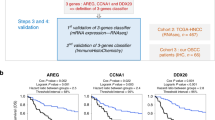Abstract
Loss of heterozygosity (LOH) on the long arm of chromosome 21 (21q) is observed in several human malignancies. We identified novel tumour suppressor loci on this region in primary oral squamous cell carcinomas (OSCCs). To further determine the role of 21q deletions in oral cavity tumorigenesis, 63 OSCCs were examined for LOH at 21q using 7 microsatellite markers. LOH was observed in 32 of 63 cases (50.8%) that were informative for at least one of the loci analysed. Two distinct deleted regions were identified at chromosomal region 21q11.1. The possible involvement of ANA (abundant in neuroepithelium area), a candidate tumour suppressor gene (TSG) located on 21q11.2–21.1, was also evaluated for 20 OSCCs and 9 OSCC-derived cell lines. 60% of tumours (12/20) and 88.9% (8/9 cell lines) showed absent or reduced mRNA gene expression; only one OSCC case had a nucleotide substitution in the ANA gene. Interestingly, the frequency of the suppressed ANA mRNA expression was greater in stage IV tumours than in earlier stages. In addition, re-expression of the ANA gene mRNA was induced in 4 cell lines after treatment with 5-aza-2′-deoxycytidine, a DNA demethylating agent. These findings demonstrate that there may be at least 2 distinct TSGs on 21q11.1; loss of ANA gene expression could be involved in the progression of human OSCC; and aberrant methylation of the ANA gene promoter may participate in the transcriptional silencing of the gene in oral cancer cells. © 2001 Cancer Research Campaign
Similar content being viewed by others
Article PDF
Change history
16 November 2011
This paper was modified 12 months after initial publication to switch to Creative Commons licence terms, as noted at publication
References
Ah-See KW, Cooke TG, Pickjord IR, Soutar D and Balmain A (1994) An allelotype of squamous cell carcinoma of the head and neck using microsatellite markers. Cancer Res 54: 1617–1621
Aoki T, Mori T, XiQun D, Nishira T, Matsubara T and Nakamura Y (1994) Allelotype study of esophageal carcinoma. Genes Chromosomes Cancer 10: 177–182
Chiba I, Shindoh M, Yasuda M, Yamazaki Y, Amemiya A, Sato Y, Fujinaga K, Notani K and Fukuda H (1996) Mutations in the p53 gene and human papillomavirus infection as significant prognostic factors in squamous cell carcinomas of the oral cavity. Oncogene 18: 1663–1668
Cliby W, Ritland S, Hartmann L, Dodson M, Halling KC, Keeney G, Podratz KC and Jenkins RB (1993) Human epithelial ovarian cancer allelotype. Cancer Res 53: 2393–2398
Fearon ER (1998) Tumor suppressor genes. The Genetic Basis of Human Cancer, Vogelstein B, Kinzler KW (eds), pp. 229–236, McGraw-Hill: New York
Field JK, Kiaris H, Risk JM, Tsiriyotis C, Adamson R, Zoumpourlis V, Rowley H, Taylor K, Whittaker J, Howard P, Beirnie JC, Gosney JR, Woolgar J, Vaughan ED, Spandidos DA and Jones AS (1995) Allelotype of squamous cell carcinoma of the head and neck: fractional allele loss correlates with survival. Br J Cancer 72: 1180–1188
Heinzel PA, Balaram P and Bernard HU (1996) Mutations and polymorphisms in the p53, p21 and p16 genes in oral carcinomas of Indian betel quid chewers. Int J Cancer 68: 420–423
Hermanek P and Sobin LH (1987). UICC, TNM Classification of Malignant Tumours, 4th ed. pp. 16–18, Springer Verlag: Berlin
Ishwad CS, Ferrell RE, Rossie KM, Appel BN, Johnson JT, Myers EN, Law JC, Srivastava S and Gollin SM (1995) Microsatellite instability in oral cancer. Int J Cancer (Pred Oncol) 64: 332–335
Jones PA and Laird PW (1999) Cancer epigenetics comes of age. Nature Genet 21: 163–167
Kohno T, Kawanishi M, Matsuda S, Ichikawa H, Takada M, Ohki M, Yamamoto T and Yokota J (1998) Homozygous deletion and frequent allelic loss of the 21q11.1–q21.1 region including the ANA gene in human lung carcinoma. Genes Chromosomes Cancer 21: 236–243
Largery JS, Meltzer SJ, Sauk JJ and Hebert CA and Archibald (1994) Loss of heterozygosity involving the APC gene in oral squamous cell carcinoma. Oral Surg Oral Med Oral Path 77: 260–263
Maestro R, Gasparotto D, Vukosavljevic T, Barzan L, Sulfaro S and Boiocchi M (1993) Three discrete regions of deletion at 3p in head and neck cancers. Cancer Res 53: 5775–5779
Maniatis T, Fritsch EF and Sambrook J (1982). Molecular Cloning, a Laboratory Manual, ed. 1. pp. 280–281, Cold Spring Harbor Laboratory Press: Cold Spring Harbor, NY
Miracca EC, Kowalski LP and Nagai MA (1999) High prevalence of p16 genetic alterations in head and neck tumours. Br J Cancer 81: 677–683
Ogawara K, Miyakawa A, Shiiba M, Uzawa K, Watanabe T, Wang X-L, Sato T, Kubosawa H, Kondo Y and Tanzawa H (1998) Allelic loss of chromosome 13q14.3 in human oral cancer: correlation with lymph node metastasis. Int J Cancer 79: 312–317
Ohgaki K, Iida A, Kasumi F, Sakamoto G, Akimoto M, Nakamura Y and Emi M (1998) Mapping of a new target region of allelic loss to a 6-cM interval at 21q21 in primary breast cancers. Genes Chromosomes Cancer 23: 244–247
Sakata K, Tamura G, Nishizuka S, Maesawa C, Suzuki Y, Iwaya T, Terashima M, Saito K and Satodate R (1997) Commonly deleted regions on the long arm of chromosome 21 in differentiated adenocarcinoma of the stomach. Genes Chromosomes Cancer 18: 318–321
Sato S, Nakamura Y and Tsuchiya E (1994) Difference of allelotype between squamous cell carcinoma and adenocarcinoma of the lung. Cancer Res 54: 5652–5655
Schwerdtle RF, Storkel S, Neuhaus C, Brauch H, Weidt E, Brenner W, Hohenfellner R, Huber C and Decker HJ (1996) Allelic losses at chromosomes 1p, 2p, 6p, 10p, 13q, 17p, and 21q significantly correlate with the chromophobe subtype of renal cell carcinoma. Cancer Res 56: 2927–2930
Scully C and Field JK (1997) Genetic aberrations in squamous cell carcinoma of the head and neck (SCCHN), with reference to oral carcinoma (Review). Int J Oncol 10: 5–21
Timmermann S, Hinds PW and Münger K (1998) Re-expression of endogenous p16ink4ain oral squamous cell carcinoma lines by 5-aza-2′-deoxycytidine treatment induces a senescence-like state. Oncogene 17: 3445–3453
Uzawa K, Yoshida H, Suzuki H, Tanzawa H, Shimazaki J, Seino S and Sato K (1994) Abnormalities of the adenomatous polyposis coli gene in human oral squamous cell carcinoma. Int J Cancer 58: 814–817
Uzawa K, Suzuki H, Yokoe H, Tanzawa H and Sato K (1995) Mutational state of p16/CDKN2 and VHL genes in squamous-cell carcinoma of the oral cavity. Int J Oncol 7: 895–899
Uzawa K, Suzuki H, Komiya A, Nakanishi H, Ogawara K, Tanzawa H and Sato K (1996) Evidence for two distinct tumor-suppressor gene loci on the long arm of chromosome 11 in human oral cancer. Int J Cancer 67: 510–514
Wang X-L, Uzawa K, Imai FL and Tanzawa H (1999) Localization of a novel tumor suppressor gene associated with human oral cancer on chromosome 4q25. Oncogene 18: 823–825
Wahi PN (1971) Histological typing of oral and oropharyngeal tumours. International Histological Classification of Tumours, No. 4, World Health Organization: Geneva
Wu CL, Roz L, Sloan P, Read AP, Holland S, Porter S, Scully C, Speight PM and Thakker N (1997) Deletion mapping defines three discrete areas of allelic imbalance on chromosome arm 8p in oral and oropharyngeal squamous cell carcinomas. Genes Chromosomes Cancer 20: 347–353
Yamamoto N, Uzawa K, Miya T, Watanabe T, Yokoe H, Shibahara T, Noma H and Tanzawa H (1999) Frequent allelic loss/imbalance on the long arm of chromosome 21 in oral cancer: Evidence for three distinct tumor suppressor gene loci. Oncol Rep 6: 1223–1227
Yoshida Y, Matsuda S, Ikematsu N, Kawamura-Tsuzuku J, Inazawa J, Umemori H and Yamamoto T (1998) ANA, a novel member of Tob/BTG1 family, is expressed in the ventricular zone of the developing central nervous system. Oncogene 16: 2687–2693
Author information
Authors and Affiliations
Rights and permissions
From twelve months after its original publication, this work is licensed under the Creative Commons Attribution-NonCommercial-Share Alike 3.0 Unported License. To view a copy of this license, visit http://creativecommons.org/licenses/by-nc-sa/3.0/
About this article
Cite this article
Yamamoto, N., Uzawa, K., Yakushiji, T. et al. Analysis of the ANA gene as a candidate for the chromosome 21q oral cancer susceptibility locus. Br J Cancer 84, 754–759 (2001). https://doi.org/10.1054/bjoc.2000.1656
Received:
Revised:
Accepted:
Published:
Issue date:
DOI: https://doi.org/10.1054/bjoc.2000.1656
Keywords
This article is cited by
-
Direct Downregulation of B-Cell Translocation Gene 3 by microRNA-93 Is Required for Desensitizing Esophageal Cancer to Radiotherapy
Digestive Diseases and Sciences (2017)
-
Down-regulation of BTG3 promotes cell proliferation, migration and invasion and predicts survival in gastric cancer
Journal of Cancer Research and Clinical Oncology (2015)
-
Decreased expression of BTG3 was linked to carcinogenesis, aggressiveness, and prognosis of ovarian carcinoma
Tumor Biology (2013)
-
The candidate tumor suppressor BTG3 is a transcriptional target of p53 that inhibits E2F1
The EMBO Journal (2007)
-
Ubiquitous mitochondrial creatine kinase downregulated in oral squamous cell carcinoma
British Journal of Cancer (2006)



